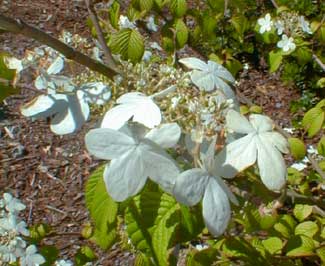
'Shasta' Doublefile Viburnum; aka,
Japanese Highbush Cranberry
"See you, brother, Cranberry Fruit --
He! ho! ho! the merry blade! --
Hugs & pets & pats yon newt,
Teasing every wilful maid."
-William Butler Yeats
(1865-1939)
(1865-1939)
In 1954, the National Arboretum took a selected specimen of Viburnum plicatum forma tomentosum & crossbred it to the cultivated variety V. plicatum f. tomentosum 'Mariesii.' Thus began the first breeding program for an improved doublefile viburnum. In 1968, a select specimen from this hybrid's second generation became the start of the now-famed 'Shasta' Viburnum. In 1979, it was named & introduced to the gardening public.
For the usual doublefile flower, tiny central fertile florets are ringed by larger sterile florets, but for 'Shasta' the sterile florets are more than twice the usual size, & some of these enhanced florets are scattered amidst the small fertile florets. The cyme or lacecaps are four or five inches in diamater, occurring in great numbers in two rows along the branches, the two rows lending it the name "doublefile."
May's showy lacecaps are even showier if they can be viewed from above. So planting at the foot of a hill with higher overlook maximizes their snowy effect during spring bloom. In a maximumly flowery year, the whole shrub can seem to have vanished into snow.
The flowers are followed by bright red drupes in July. Birds as a rule wait to eat them until September, when the drupes turn black. So the highly decorative red berries last for many weeks before they become treats for birds.
These are excellent shrubs for birdlovers, because they do provide food for birds in that slot of time after summer-fruiting briars are finished & before hard frosts sweeten the tartest berries of hawthorns, cotoneasters, & suchlike.
Because of its fruit 'Shasta' should be favored over the fully-double snowball doublefiles which have none of the smaller fertile florets & thereby possess less ornamentality after flowering, besides providing no cranberries for the birds.
'Shasta' has a mostly horizontal growth with a ten-year height of six to seven feet, & width of ten to twelve feet. It is very responsive to careful pruning & can be trained to be shorter so as to form a groundcover-shrub, or kept a little narrower.
Pleated green leaves turn maroon in autumn. After leaf-fall, the form of the horizontal limbs has its own wintry charm.
In the Northwest it wants full sun, though inland or further south it may want just a little shade. It is ideal for USDA zones 5 or 6, up to zone 8, but is not heat-hardy for warmer climates. It prefers moist well-draining soil but can adapt to somewhat dryer soils, though does poorly in outright droughty conditions.
Because of their hardiness & adaptability in our region, they are often used in such places as the front of post offices where care is hit & miss, yet they always look pretty darned healthy. With better soil & moderate watering in a well-cared for garden, however, they far exceed in beauty those hardship specimens.
I failed to get a good photo of the shrub installed (in 2005) in a garden where I was doing landscaping, as each time I brought my camera, the days were ultra-sunny & my camera works better on overcast days. But one photo will do, & since shooting it, the shrub has tripled in size, but I've not tried to photograph it again as I've enough to do just documenting my own garden. Maybe I'll get 'round to it "next May" I keep telling myself, as the Mays tick by ever closer to the sweet loam of the grave.